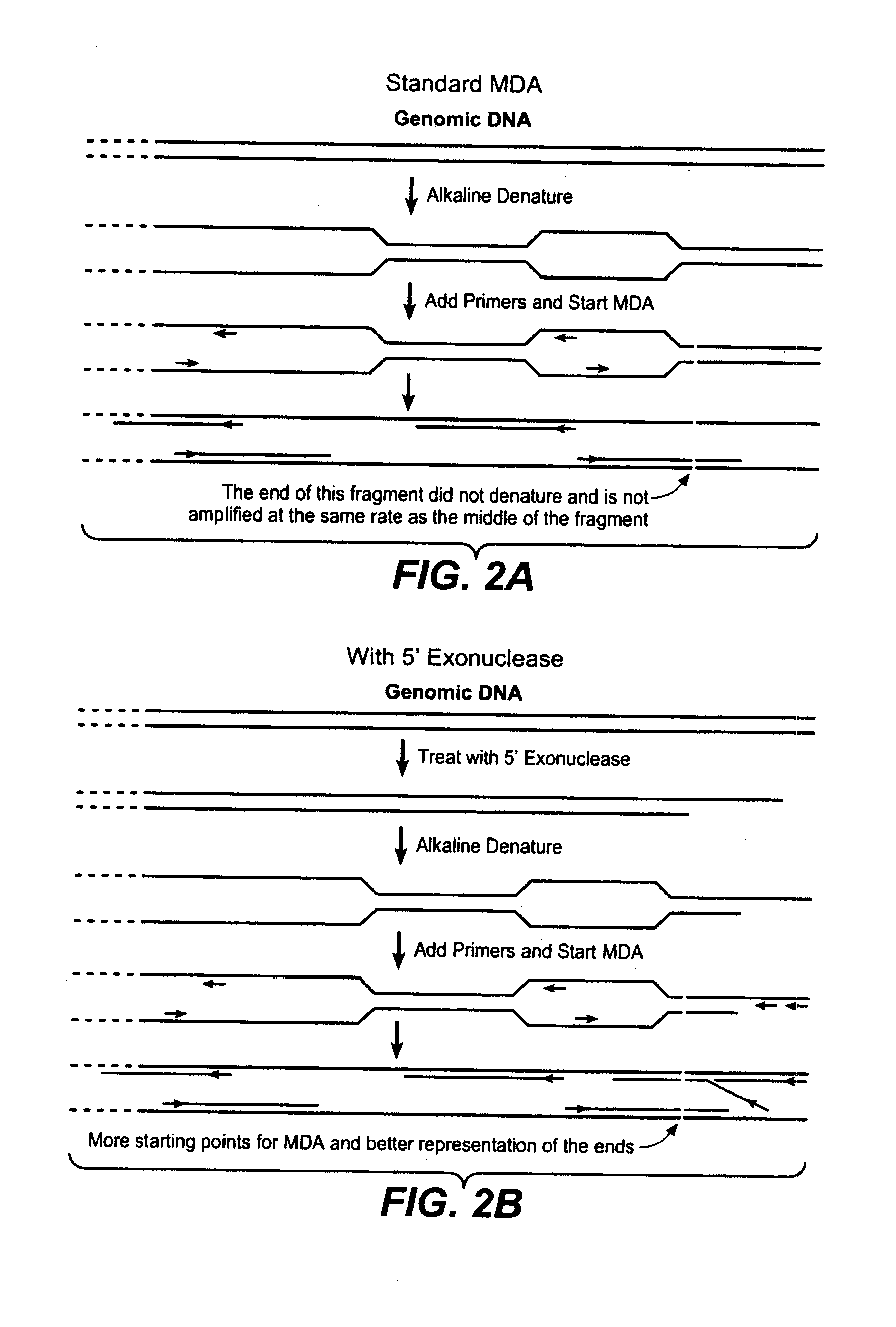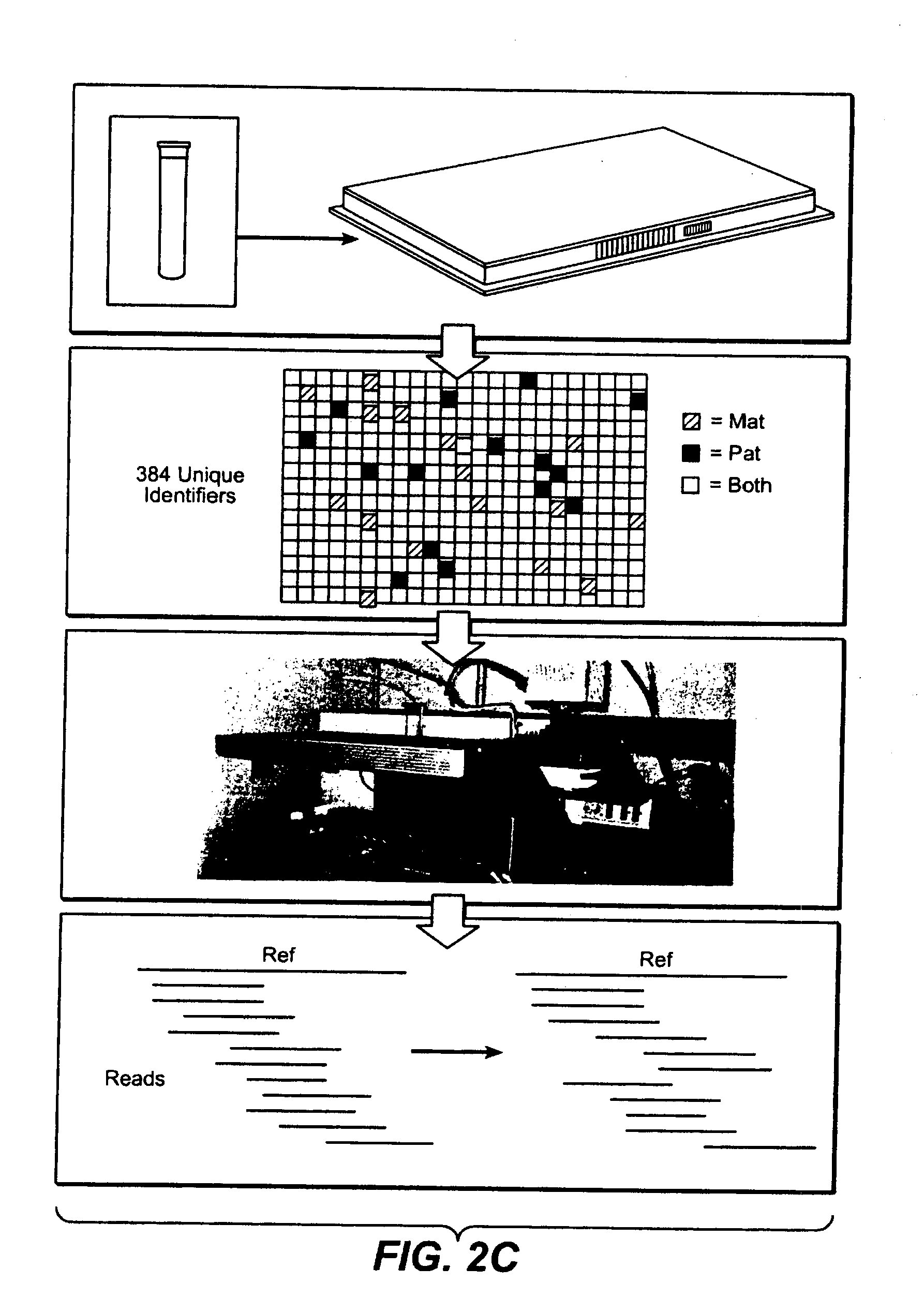Nucleic Acid Sequencing and Process
a technology of nucleic acid and sequencing method, applied in the field of nucleic acid sequencing and process, can solve the problems of placing a significant limit on the overall sequencing efficiency, the inability to achieve single-molecule sequencing, and the limited range of conventional methods of sequencing
- Summary
- Abstract
- Description
- Claims
- Application Information
AI Technical Summary
Benefits of technology
Problems solved by technology
Method used
Image
Examples
example 1
Producing DNBs
[0408]The following are exemplary protocols for producing DNBs (also referred to herein as “amplicons”) from nucleic acid templates of the invention comprising target nucleic acids interspersed with one or more adaptors. Single-stranded linear nucleic acid templates are first subjected to amplification with a phosphorylated 5′ primer and a biotinylated 3′ primer, resulting in a double-stranded linear nucleic acid templates tagged with biotin.
[0409]First, streptavidin magnetic beads were prepared by resuspending MagPrep-Streptavidin beads (Novagen Part. No. 70716-3) in 1× bead binding buffer (150 mM NaCl and 20 mM Tris, pH 7.5 in nuclease free water) in nuclease-free microfuge tubes. The tubes were placed in a magnetic tube rack, the magnetic particles were allowed to clear, and the supernatant was removed and discarded. The beads were then washed twice in 800 μl 1× bead binding buffer, and resuspended in 80 μl 1× bead binding buffer. Amplified nucleic acid templates (a...
example 2
Single and Double c-PAL
[0415]Different lengths of fully degenerate second anchor probes were tested in a two anchor probe detection system. The combinations used were: 1) standard one anchor ligation using an anchor that binds to the adaptor adjacent to the target nucleic acid and a 9-mer sequencing probe, reading at position 4 from the adaptor 2) two anchor ligation using the same first anchor and a second anchor comprising a degenerate five-mer and a 9-mer sequencing probe, reading at position 9 from the adaptor; 3) two anchor ligation using the same first anchor and a second anchor comprising a degenerate six-mer and a 9-mer sequencing probe, reading at position 10 from the adaptor; and 4) two anchor ligation using the same first anchor and a second anchor comprising a degenerate eight-mer and a 9-mer sequencing probe, reading at position 12 from the adaptor. 1 μM of a first anchor probe and 6 μM of a degenerate second anchor probe were combined with T4 DNA ligase in a ligase rea...
example 3
Human Genome Sequencing using Unchained Base Reads on Self-Assembling DNA
[0482]Three human genomes were sequenced, generating an average of 45- to 87-fold coverage per genome and identifying 3.2-4.5 million sequence variants per genome. Validation of one genome dataset demonstrated a sequence accuracy of about 1 false variant per 100 kilobases.
[0483]Generation of Template Sequencing Substrates
[0484]Sequencing substrates were generated by means of genomic DNA fragmentation and recursive cutting with type IIS restriction enzymes and directional adaptor insertion (FIGS. 6 and 39B). The 4-adaptor library construction process is summarized in FIG. 6. This process resulted in: (i) high yield adaptor ligation and DNA circularization with minimal chimera formation, (ii) directional adaptor insertion with minimal creation of structures containing undesired adaptor topologies, (iii) iterative selection of constructs with desired adaptor topologies by PCR, (iv) efficient formation of strand-sp...
PUM
| Property | Measurement | Unit |
|---|---|---|
| diameter | aaaaa | aaaaa |
| temperature | aaaaa | aaaaa |
| temperature | aaaaa | aaaaa |
Abstract
Description
Claims
Application Information
 Login to View More
Login to View More - Generate Ideas
- Intellectual Property
- Life Sciences
- Materials
- Tech Scout
- Unparalleled Data Quality
- Higher Quality Content
- 60% Fewer Hallucinations
Browse by: Latest US Patents, China's latest patents, Technical Efficacy Thesaurus, Application Domain, Technology Topic, Popular Technical Reports.
© 2025 PatSnap. All rights reserved.Legal|Privacy policy|Modern Slavery Act Transparency Statement|Sitemap|About US| Contact US: help@patsnap.com



